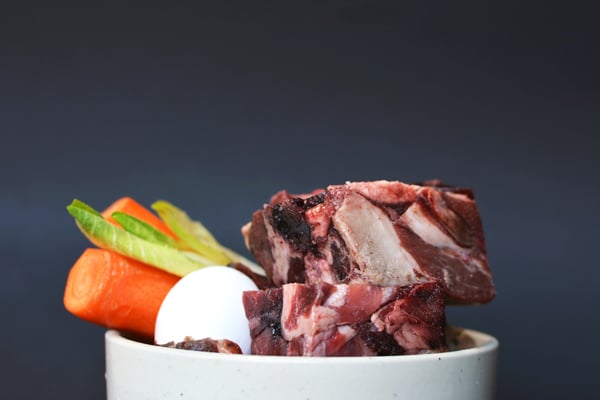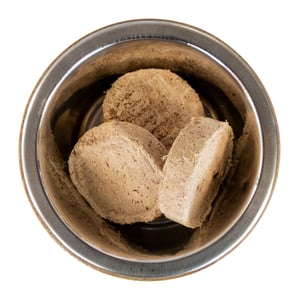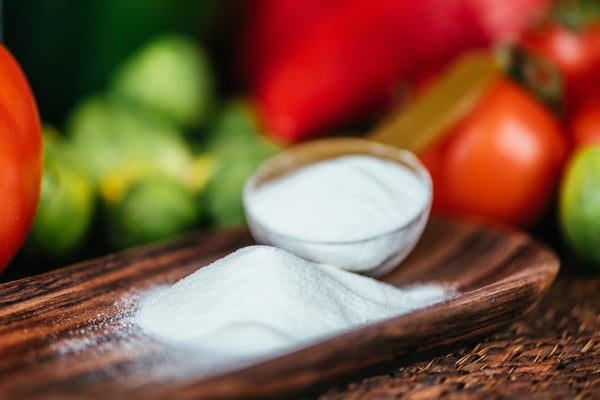My shopping cart
Your cart is currently empty.
Continue Shopping
Have you been considering feeding a raw dog food diet, or are you wondering what all the hype is about? Let’s break down the key benefits of raw dog food and compare them to other diet formats to help you choose the best food for your dog.
Raw diets supply the most natural and complete form of nutrition that you can provide for your dog. Here are some of the most common benefits of raw dog food diets:
The benefits of feeding a nutritionally-balanced raw diet exceed those of standard kibble or canned foods. If you are looking to solve a health issue, improve digestion, or just provide superior nutrition to your dog, then raw might be a great option for you.
Based on anatomical evidence, dogs have adapted to cooked commercial diets, but like carnivores, are still physically designed in many ways to process raw meat-rich diets. Despite their omnivorous qualities, canines can still process animal protein as efficiently as their ancestral predecessors.
Dog Nutritional Requirements: An In-Depth Dive

The bioavailability of an ingredient is how digestible and usable an ingredient is for your dog’s body. Processing or cooking the ingredients to make commercial dog food changes the digestibility.
For example, cooking raw vegetables can remove the cellulose casing, which is indigestible, but processing and cooking ingredients can also degrade the quality of nutrients. When ingredients are exposed to high temperatures, like those involved in dog food manufacturing, they may yield less nutrition than before it was processed.
The heat from processing can also change the composition of fatty acids, amino acids, and enzymes used to support many functions in your dog's body.
A dog’s digestive system is intended to break down raw or minimally processed material. Altering its natural state can make many of the essential nutrients less bioavailable, recognizable or as nutrient dense, making the dog’s body work harder to attain the nutrients it needs from the food.
In the case of many low-quality commercial pet foods, processing can reduce the quantity and bioavailability of the nutrients to less than the bare minimum dietary requirements.
When all ingredients are utilized properly and the dog is receiving optimal nutrition, an increase in muscle mass and reduction of fat can be seen, supporting a leaner and healthier physique. You will also achieve improved energy levels and stamina, even in overweight, senior, and limited mobility dogs.
Your pet’s body requires water to properly excrete toxins, such as the nitrogen products, produced by your dog’s body digesting protein. The kidneys transports urea, ammonia, and nitrogen compounds to the urinary tract for waste removal.
Dehydration can decrease digestive function, slow the process of waste removal, and lead to recurring urinary tract problems like infection and crystals.
The high moisture content in raw animal protein aids the kidneys in flushing these toxins through the urinary tract. This support can also reduce the risk of stress on the kidneys and prevent possible kidney diseases in their senior years.
Canned diets do provide additional moisture and can aid in digestion like a raw diet, but still, lack the nutritional equivalency of raw unprocessed ingredients.

Dehydrated, freeze-dried, and air-dried raw diets offer a much more convenient format to feed raw. They are a great raw alternative for travel or last-minute meals and can be used as a treat or a meal topper.
The only thing that these diets are missing is moisture. Many freeze-dried and some dehydrated diets are designed to be rehydrated, allowing you to make only what you need.
For the formats that can be fed as is, I encourage you to find other ways to increase hydration in your pet's diet. Feeding broths, goat’s milk, and raw bones are a great way to ensure that your pet is receiving all of the benefits of raw.

Synthetic vitamins are not always nutritionally equivalent or as biologically available as naturally sourced vitamins from raw ingredients. While the absorption rate for some synthetic and natural vitamins is similar, other vitamins are more potent in their natural form.
For example, natural Vitamin E is roughly twice as bioavailable as synthetic Vitamin E.
Vitamin C is also thought to be more efficiently utilized by your dog's body when the natural flavonoids in their fruit hosts are present. "A significant proportion of animal studies show enhanced circulating and organ levels of vitamin C in the presence of food-derived or purified flavonoids", according to one study.
Deficiencies caused by malabsorption of synthetic vitamins can lead to a damaging effect on cells and normal organ function, so most of the nutrients should be sourced from real foods.
Some commercial raw diets are still fortified with chelated minerals, which are minerals that are paired with an amino acid to improve their digestibility. While we don’t often see synthetic additives in Canadian raw foods, many US manufacturers are required to do this to accommodate AAFCO regulations.
This doesn’t mean that the foods were deficient in any nutrients, but fortifying the foods not only appeases government standards, it can also act as a buffer for pets that may require higher than average amounts of certain nutrients.
For pet owners who have never fed a raw diet before, the difference in stool quality can be quite remarkable. Cooked commercial diets, being less bioavailable and often more carbohydrate heavy, create more waste. The result is a larger, more odorous stool.
Raw diets leave very little waste and produce smaller, firmer stool, which is helpful for anal gland regulation.
Very little is wasted during digestion, so everything that is excreted is broken down into a completely biodegradable form. Fast decomposition will leave practically no backyard clean up.
Kibble diets, even those of premium quality, require preservatives to prevent spoilage and maintain long shelf lives. These preservatives do their job right until the smelly end; they preserve not just the food, but also the waste, slowing natural decomposition.

Enzymes in raw meat provide superior dental benefits compared to the abrasion from chewing kibble. These enzymes work by combating bacteria in the oral cavity that can cause dog breath, plaque and tartar build up, inflammation of the gums, and the potential for other serious dental health issues.
This does not omit the need for regular teeth brushing and dental care, but it will prevent rapid bacteria build up in the mouth.
Feeding raw bones and natural chews can also provide superior dental health benefits. The abrasion from chewing them removes bacteria from hard to reach molars and strengthens their jaw.
Raw and unprocessed ingredients contain higher, unaltered sources of omega fatty acids and amino acids than processed and cooked ingredients. These essential nutrients are vital to maintaining your dog's healthy skin and soft, shiny coat, as well as a variety of your dog’s other internal systems.
Digestion is the foundation of their bodies. Feeding a diet that supports improved digestion will allow essential nutrients to circulate appropriately to improve overall skin and coat health.
Raw feeders typically see improvement within weeks of switching to a raw diet, including reduced shedding and less dander. For people with pet allergies, raw fed pets are ideal for minimizing allergy triggers.

Higher bioavailability of food improves the efficiency of your dog's metabolism. When all ingredients are utilized properly and the dog is receiving optimal nutrition, their metabolism aids in burning fatty deposits and increasing and maintaining muscle mass.
Increased energy levels and stamina can be seen even in overweight and senior dogs, and dogs with mobility issues, allowing for healthy exercise routines to be implemented.
Raw diets look like the perfect diet choice on paper, but there are some inconveniences attached to feeding a raw dog food diet. Here are some common factors that can scare pet owners away from feeding raw.

Probably the most obvious barrier for pet owners that are hesitant about raw pet food is the price tag. To call it sticker shock may be an understatement.
Of course, to truly understand we need to break down the feeding guidelines and weigh the benefits before we let the cost of raw feeding shock us too much.
Yes, raw food is more expensive than most cooked commercial diets, but the long term benefits and savings may help soften the price a bit.
Improved overall health, as a result of raw feeding, will significantly reduce vet visits, other than routine check-ups, and can reduce the risk of serious health conditions later in life.
I know it’s hard to justify a jump in the cost for pet care, but paying a little extra for food every month may also help you cut costs on other items that you use to care for your pet.
Some supplements, waste management supplies, and grooming supplies may not be needed as often or at all after switching to a raw diet.
This sticker shock is definitely a turn off for potential raw food feeders, but for many, the long term benefits of feeding raw do outweigh the short term cost.

There is a lot of fear and confusion around the safety of feeding your pet raw meat. Safe food handling practices are required for raw feeding. Here are some helpful tips that can help keep everyone in your house safe:

Another drawback to choosing to raw feed is the preparation. Unlike kibble that can be simply scooped served and forgotten about, raw feeding takes a little bit more work.
You need to be prepared to plan your dog’s meals in advance by portioning them and defrosting the correct amount of food from a single meal to up to 2-3 days worth of meals.

Pet owners choose raw diets for some or all of the benefits, and when fed properly, they end up seeing benefits they didn’t even know would happen. If you practice common sense and desire to improve your pet’s overall health, I encourage you to take a chance on raw. You won’t be disappointed, and neither will your dog.
By Krystn Janisse
https://blog.homesalive.ca/benefits-of-raw-dog-food